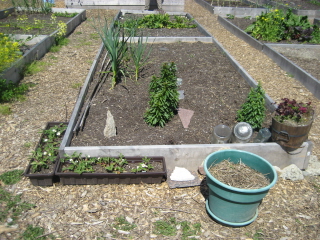In truth, I’ve been making the four block trek to my community garden plot for a few weeks now, so the 2010 gardening season hasn’t JUST begun. In fact, I have even begun to develop the slightest hint of a flip flop tan.
 Here’s what the plot looked like after I worked in a bit of rich, horse manure, a bag of mushroom manure, and some winter barley bits in late April.
Here’s what the plot looked like after I worked in a bit of rich, horse manure, a bag of mushroom manure, and some winter barley bits in late April.
I am, after all, the Bumbling Gardener, so I rely a lot on hearsay from a variety of “experts” as to what I’m supposed to be doing. Someone said I shouldn’t plant right away after blending in manure because it can be too strong (acidic maybe?) and will burn the seeds. It needs to cure a bit. That makes sense, so I blended and let it rest.
Re: the barley…
Over the winter I grew a bit of winter barley in order to “fix the nitrogen.” The way I understand it, there are 2 key things to know: (a) some plants need more nitrogen than others; and (b) some plants taketh and some plants giveth. Winter barley giveth, peas and beans taketh. So I planted the barley where I would plant some beans in spring. I have NO idea if this will help, but you’ll know when I do by how well the beans are doing. Stay tuned.
I decided to blend in the barley plant bits while I was doing the rest of the blending, so it could become compost as it decomposed. You know, circle of life and all that. And maybe it will “fix the nitrogen” some more, too.
Things I Learned From Blending
Here’s one tip for you to keep in mind if you try it: you can blend in the barley grass bits, but the roots are a tangly clump and you’re better off just to yank them out.
Something else I’ve realized with the blending experience is that I also turned up bits of the coconut coir I laid last year to help with moisture retention. I’ll have to keep an eye on that.
And, realized just how many wood chips and twigs there were in the compost we so gratefully accepted from the City of Vancouver last year. I’m not complaining (it was FREE and they brought us truck loads!), just saying. There are little bits of plastic and glass, as well as small stones, so I’m going through and picking those out a bit at a time.
Then came the planting…

Another organic slug killer is a diatomatious powder you can get at a nursery. It’s finely crushed coral that you mix with water and spray on your plants and on the ground around them. The only concern is to not breath it in as it will cut up your lungs just as it cuts up the slugs. Works great!
Thanks, that’s one I’d never heard of.